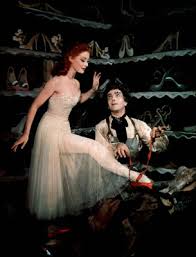
I have heard actors say that creating a character consists of putting the pieces together. They might start by finding the voice, or by finding the posture. Every actor has their own method of finding their way into the characterization of the part. Very often the actor starts with the physicality and the look of the character and that is where we come in as costume designers. It can be tremendously helpful for the actor if we can work with them early in the rehearsal process to find the look. It could be the hair style, or beard and wig. Or it can be very helpful to find the shoes that will work for the look or give the actor the right feel. As Laurence Olivier said “Always start with the shoes”
In order to be efficiently helpful the costume designer needs to know all the basic pieces of the costume so that you can guide the actor into getting the right shoes that work for the character and the period. To give an extreme example there is no good having the actor rehearse in tennis shoes if they are going to be wearing a shoe with a heel. If the character is going to be dancing then they will need a shoe with a strap or laces. Hurray for character shoes! The actor should be able to use the shoes in rehearsal as soon as that is possible. Remember to talk with the director and stage manager about the logistics for the actors to get their shoes and bring them back. Don’t just hand the actor a pair of shoes and expect to ever see them again, it’s part of your job to keep track of the costumes, not theirs.
As costume designers sometimes we focus on the big parts of the costumes but having a firm grasp on the smaller parts is often more important. Sometimes things come up in rehearsals that will necessitate changing your designs. Once I was informed by the stage manager that the director and actor had decided that his character would have a peg leg. That involved a lot of work to make the leg and harness and I had to change the costume to show the peg leg and accommodate his own folded leg. It was difficult because it took us so long to make the peg leg there wasn’t much time for the actor to rehearse in it. I brought that up in the production meeting but by then the decision was made. The costume shop spent way too much time working on the peg leg and it wasn’t really worth all the pain that the actor suffered. I’m sure he’ll never have that bright idea again. But live and learn.
On another show the director decided that King Richard III had withered legs and he wanted braces. I was working as a costume crafts person for that show and after conferring with the designer I went out and bought actual leg braces and decorated them to fit in with the Medieval style of the rest of the costumes. They had the advantage of being sturdy and light and worked very well. 
Hats fall into the same category as shoes. It is very important for the actor to have the hat or a reasonable facsimile as soon as possible. You don’t want to toss an aside to the actor at the last fitting that he is going to be wearing a hat and a wig. You will see a look of terror cross his face and probably your well chosen hat will be cut at the last moment after it falls off. Hats are a nuisance onstage. I love them and I think that they look wonderful and are the greatest way to finish a wonderful costume. But, they shade the actors faces, they fall off, if they need to be taken off onstage there is nowhere to put them. Offstage they get tossed in a corner and trampled. It’s all very difficult but we have to persist and the best way is to give them a rehearsal hat early on and keep your fingers crossed.
Costume accessories make the costume complete.